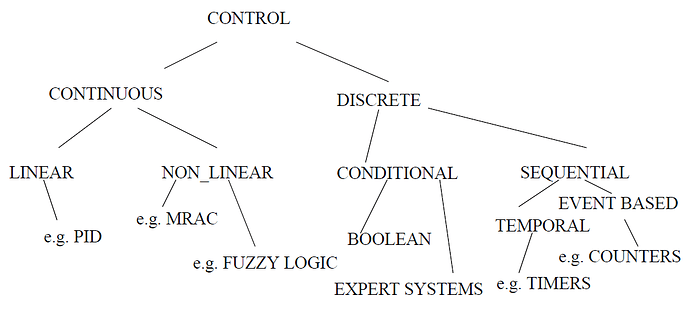Designing software for control systems is difficult. Experienced controls engineers have learned many techniques that allow them to solve problems.
The below are the Basic Types and Categories of Control System.
Types of Control System
Continuous Control System
The values to be controlled change smoothly. e.g. the speed of a car. •
Logical/Discrete Control System
The value to be controlled are easily described as on-off. e.g. the car motor is on-off.
NOTE: all systems are continuous but they can be treated as logical for simplicity.
e.g. “When I do this, that always happens!” For example, when the power is turned on, the press closes!
Linear Control System
Can be described with a simple differential equation. This is the preferred starting point for simplicity, and a common approximation for real world problems.
e.g. A car can be driving around a track and can pass same the same spot at a constant velocity. But, the longer the car runs, the mass decreases, and it travels faster, but requires less gas, etc. Basically, the math gets tougher, and the problem becomes non-linear.
e.g. We are driving the perfect car with no friction, with no drag, and can predict how it will work perfectly.
Non-Linear Control System
This is how the world works and the mathematics become much more complex.
e.g. As rocket approaches sun, gravity increases, so control must change.
Sequential Control System
A logical controller that will keep track of time and previous events.
Difference between these Control Systems
The difference between these control systems can be emphasized by considering a simple elevator. An elevator is a car that travels between floors, stopping at precise heights. There are certain logical constraints used for safety and convenience.
The points below emphasize different types of control problems in the elevator.
Logical:
- The elevator must move towards a floor when a button is pushed.
- The elevator must open a door when it is at a floor.
- It must have the door closed before it moves. etc.
Linear:
- If the desired position changes to a new value, accelerate quickly towards the new position.
- As the elevator approaches the correct position, slow down.
Non-linear:
1 Accelerate slowly to start.
2. Decelerate as you approach the final position.
3. Allow faster motion while moving.
4. Compensate for cable stretch, and changing spring constant, etc.
Logical and sequential control is preferred for system design. These systems are more stable, and often lower cost. Most continuous systems can be controlled logically.
But, some times we will encounter a system that must be controlled continuously. When this occurs the control system design becomes more demanding. When improperly controlled, continuous systems may be unstable and become dangerous.
When a system is well behaved we say it is self regulating. These systems don’t need to be closely monitored, and we use open loop control.
An open loop controller will set a desired position for a system, but no sensors are used to verify the position. When a system must be constantly monitored and the control output adjusted we say it is closed loop.
A cruise control in a car is an excellent example. This will monitor the actual speed of a car, and adjust the speed to meet a set target speed.
Many control technologies are available for control. Early control systems relied upon mechanisms and electronics to build controlled. Most modern controllers use a computer to achieve control. The most flexible of these controllers is the PLC (Programmable Logic Controller).
